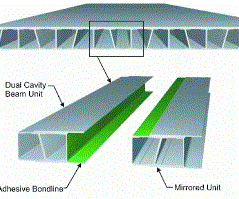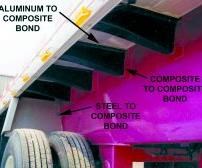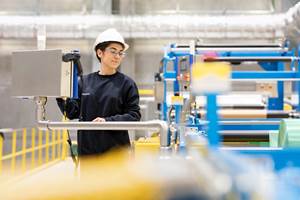A guide to selection of methacrylate, urethane and epoxy adhesives
A practical examination of the complexities of adhesive selection.
Composites and adhesives are made for each other. With proper design and material selection and good assembly practices, bonded joints can be stronger and more fatigue resistant than mechanically fastened joints. Adhesive layers weigh less than bolts and rivets, and with no holes to drill (which weaken the structure and may permit ingress of moisture) and fasteners to install, there can be significant labor savings and more rapid production rates.
There are three major groups of adhesives used in composites bonding: urethanes, epoxies and methacrylates. While each type has general properties that recommend it for certain applications, no one type is desirable in all applications. In addition, adhesive formulations may vary significantly within each type, based on a number of performance-related and practical considerations. The key to adhesive selection is to find the one formulation that best embodies the desired balance of performance properties and processing parameters.
In the vast majority of situations the general performance goal is a bonded joint stronger than the parts being bonded together. On rare occasions, however, the bond is intentionally weaker so that the joint will fail first, preventing damage to an expensive piece of structure. In all cases the bonded joint must be able to sustain all expected in-service loads and environmental conditions, which can vary considerably.
For that reason, bond strength may be defined in several ways, depending on the forces to be applied to the joint in service. The adhesive may need good lap-shear strength or good peel strength or both. Lap-shear strength refers to the ability to maintain adhesion when force is applied parallel to the bond line, while peel strength describes the ability to adhere when pulling force is applied perpendicular to the bond line.
Adhesives also can play a significant role in extending the useful life of bonded composite parts. In a properly designed bonded joint, ductile adhesives - those with high elongation-to-failure - absorb shock loads, shielding the adjacent structure from fatigue. Because all adhesives will harden in cold temperatures and soften in hot temperatures, an adhesive must be selected to have adequate ductility throughout its in-service temperature range.
Composites applications also may require performance features unrelated to adhesion. For instance, in transportation applications subject to flame/smoke/toxicity regulation or in corrosive environments, adhesive flammability and/or corrosivity become significant factors.
Beyond bond performance, a number of practical considerations influence adhesive selection:
Mixing method. Some two-part systems can be mixed inexpensively in a bucket with simple stirring, while others sometimes require expensive meter/mix/dispense equipment.
Surface preparation. Some adhesives require special part cleaning and/or surface conditioning to ensure good adhesion while other adhesives are more aggressive, containing solvents or other components that dissolve contaminants and/or etch surfaces.
Pot or work life. This is the amount of time after mixing that the adhesive is still able to adequately wet out the substrates. For small-area application, pot life of a few minutes may be acceptable. For large-area applications, pot life may have to extend to several hours.
Curing method. Two-part adhesives (resin and catalyst) begin to react and harden after mixing, while one-part materials are air- or heat-triggered.
Fixturing time. This is the time required for a part assembly to be clamped while the adhesive cures well enough to allow the next operation to begin, which may create a production bottleneck. The cure cycles for many adhesives may be heat-accelerated to shorten time in the fixture.
Time to full cure. Even after the joint is strong enough to start the next manufacturing process, optimal bond strength may not be reached for an extended period of time. Product is generally not delivered to the customer unless it is at full strength, a factor in scheduling.
Health/safety. The chemical composition of some adhesives may require that technicians wear gloves and/or a breathing apparatus. Production proceeds more quickly when materials are acceptable to assembly personnel.
Repairability. Some applications require that a bonded joint be separable for repair purposes. Adhesives can be selected that soften enough to break the bond at temperatures above the assembly's in-service temperature range but below the temperature at which the composite sustains heat damage. Alternatively, high lap-shear/low-peel adhesives may prove suitable in some applications.
Cost. The "total applied cost" per completed assembly includes the raw adhesive material, labor involved with application, any mixing equipment that may be required, assembly fixtures and curing ovens (if used) as well as the total production time. Each application must be analyzed to optimize fabrication costs and throughput while achieving required bond properties.
Given the range of performance and practical considerations, adhesive manufacturers today offer a variety of solutions in each of the three major categories and are willing and able to develop custom solutions to meet specific customer requirements.
Flexible urethanes
The basic chemistry of urethane adhesives dates from the early 1960s. Its most notable feature is that it is almost infinitely adjustable to meet special requirements. The urethane usage window easily spans the automotive requirement for operating in-service between -40°C and 82°C (-40°F and 180°F). Because of the inherent flexibility of the urethane chain, it is the adhesive of choice in low temperatures where epoxies and methacrylates may become too stiff and brittle. Where epoxies might typically achieve 34.5 MPa/5000 psi with 3 percent elongation at room temperature, urethanes are on the order of 20.7 MPa/3,000 psi with 75 percent elongation. Urethanes are used primarily for bonding thermoset composites, especially fiberglass, some thermoplastics and metals with corrosion-resistant coatings and paints.
"The urethane polymer has a wide window of formulation flexibility," says Keith Grover, product manager for the transportation and product assembly group at Ashland Specialty Chemicals Co. - Specialty Polymers and Adhesives Div. (Columbus, Ohio, U.S.A.). "We can easily change both the processing characteristics (viscosity, work life, fixturing time) and in-service characteristics (strength, stiffness). By varying the distance between active sites along the backbone molecule, and varying the number of active sites, we can make the resulting adhesive very soft and ductile or very rigid - or anything in-between - over its operating temperature range. And the toughness of urethanes is inherent in the urethane backbone molecule, which means that the adhesive properties do not degrade over time.
"Formulating flexibility is nearly infinite, especially as raw material suppliers come out with more and more versions of the raw materials," says Grover. "Urethanes are essentially 100 percent reactive, have extremely low VOCs [volatile organic compounds] and virtually no scent."
Mechanical properties of urethane adhesives may range from 300 percent elongation on adhesives used in applications where ductility is desired, such as providing a load-buffering bond between windshields and metal car bodies, to only 50 percent elongation in structural bonding applications where higher strength and stiffness are desired.
Urethanes are highly resistant to common chemicals, including windshield fluids, gas, oil and salt, making them especially useful in the auto industry. In some applications where parts need to be removable for repair, urethane adhesives can be formulated for high lap-shear strength but low peel strength.
During fabrication of Martin Marietta Composites' (Raleigh, N.C., U.S.A.) DuraSpan Fiber-Reinforced Composite Bridge Decks (see CT December 2003, p. 16), Ashland's Pliogrip 8000 polyurethane adhesive was used to assemble the deck components into large modules. Pultruded composite sections are bonded together in the factory to form panels that are 2.44m/8 ft by the width of the bridge, then shipped to the bridge site. The low viscosity of urethanes helps to minimize waste through use of a simple gravity-feed system. When the two parts are mixed in the disposable static mixer, they begin to react, resulting in a bead with enough "body" to avoid sag on a vertical surface. Bonding the majority of the pultruded sections with high-ductility urethane contributes to the long life of the bridge decks.
Greg Solomon, manager of composite structures for Martin Marietta Composites, explains that the Pliogrip 8000 prepolymer can be used with a family of 6000 curatives to accommodate different assembly times for different parts, and reactivity also can be modified via temperature controls on the dispensing equipment. This results in optimized processing and fixture times, thus increasing efficiency and decreasing bonding costs. In addition, the Pliogrip system uses gravity fed meter/mix/dispense equipment, which speeds application and reduces waste. The dispensing equipment, supplied by Bandit Machine (Ashland, Ohio, U.S.A.), is mobile and, with minor modifications, can be used with either 5-gal pails, 55-gal drums or 300-gal returnable totes. "The Pliogrip system has exhibited excellent lap-shear, peel and fatigue performance over the past seven years during extensive testing and field use with the DuraSpan deck system," says Solomon.
Participants in the multi-year test program for Pliogrip 8000 included the Army Corps of Engineers, Martin Marietta Composites and several universities. Tests verified fatigue life in a variety of environments and cyclic loads designed to simulate 75 to 100 years of use. It also performed very well in thermal shock testing, in which material at 82°C/180°F was suddenly plunged into a -40°C/-40°F environment.
Easy Epoxies
Epoxies are the adhesive of choice when high strength is needed, especially at elevated temperatures and in harsh environments. Epoxies tend to be more expensive than either urethanes or methacrylates, but their performance justifies the expense in many applications.
Epoxies are available in both film and paste form, and are common in the aerospace industry for structural bonding of composites (see "Niche Adhesives Proliferate for Specialized Applications," High Performance Composites, January 2004, p. 22). Paste epoxies can be purchased in one- or two-part versions, and can be designed for room-temperature or heat-accelerated cure. Work or pot lives can range from a few minutes to several hours, with the latter suitable for large assemblies. Heat-cure film epoxies can have work lives of up to 100 days in environmentally controlled layup rooms.
Mixing of two-part paste epoxies is generally simple. Components can be combined in a cup or bucket and stirred with a stick or a mixing paddle on a drill (depending on amount to be mixed). One part is the resin, the other the catalyst. For large mixes the packaging is sized so that one package of resin (Part A) plus one package of catalyst (Part B) can be emptied into a mixing bucket and stirred.
It is this mixing and application flexibility that lead Martin Marietta Composites to select Magnolia Plastic's (Chamblee, Ga., U.S.A.) Magnabond 56 A/B for installation of its prefabricated DuraSpan bridge decks. The decking system is designed to allow complete placement of a bridge deck in a day. The panels are designed for tongue-and-groove assembly. After an initial panel is placed at one end of the bridge, mixed adhesive is troweled onto panel bonding surfaces, and the tongue of each successive panel is jacked into the groove of the previously placed panel. "We needed an adhesive that could be applied at the bridge site any time of the year, in temperatures ranging from 4°C to 38°C [40°F to 100°F]," says Martin Marietta's Solomon. "It needed to be mixed easily onsite with minimal equipment, with a working time of one to two hours. Then it needed to cure rapidly to minimize the amount of time the bridge is closed for redecking."
"While urethanes were good in the factory for fabricating the panels, relatively short work life (one hour maximum) and the mixing and dispensing equipment required made them difficult to use for field work," Solomon explains. Equipment would need to be shipped to the site, and if there was an equipment breakdown, it could delay construction of the bridge. "The Magnabond 56 is easily mixed in equal parts by volume (A and B) in the same containers they are shipped in, using common hand drills and mixing blades," Solomon says, noting that the contractors can mix and apply the epoxy themselves without technical support, because the adhesive is similar to the epoxies commonly used to repair concrete. This eliminates the costs of shipping the dispensing equipment and hiring a trained technician to operate it. Epoxies also are less sensitive to moisture, which can be a problem on construction sites.
"Magnabond 56 has a high elongation to failure when compared to most epoxies and has exhibited excellent performance in both the lab and field," says Solomon. In tests, the adhesive has been applied and cured successfully at Martin Marietta's target low temperature (4°C/40°F), which extends the installation window and construction season. Further, it provides a work time of up to two hours at average temperatures, providing additional time to deal with any problems encountered while preparing, erecting and jacking the huge panels into place. The adhesive is unaffected by heat generated during asphalt application or pouring/curing of concrete, and it exhibits good performance properties throughout the range of earth surface temperatures.
Magnificant Methacrylates
Methacrylates were introduced in the 1970s as a toughened new class of adhesives. They cure very quickly and are used at room temperature. They dissolve most contaminants, so little or no surface cleaning is required - a boon to productivity. Peter Carbutt of ITW Plexus (Danvers, Mass., U.S.A.) says that in recent years methacrylates have been formulated to have the strength of epoxy but with considerably greater ductility. High ductility provides excellent fatigue life in any application where repeated shock loads are expected, such as boats, wind turbine blades and truck bed structures.
Cobalt Boats (Neodesha, Kan., U.S.A.) uses ITW Plexus methacrylates. Cobalt plastics engineer Steve Blaich explains, "We can't afford extensive training and quality supervision of shop personnel, so to minimize the chance of using the wrong adhesive in the wrong application we need adhesives that provide good bonding to as many substrates as possible. We use a limited number of methacrylates in our shop with good success. Methacrylates also allow us to go from one operation to the next without stopping to clean surfaces before bonding."
Although the company constantly evaluates new products, Cobalt uses the well-established MA555 product to bond fiberglass stringers into fiberglass hulls. The baby-blue MA555 adhesive is applied to the hull in a bead 2.5 cm to 3.8 cm (1 inch to 1.5 inch) wide, using a "Big Willie" pumping system supplied by GS Manufacturing (Costa Mesa, Calif., U.S.A.). The bead is sized to fill the gap and be forgiving of dimensional mismatches between the hull and stringers. The MA555 is formulated specifically for this bead size. Carbutt explains that it is important to select the right adhesive for the desired bead size. Each adhesive has a range in which it works well, but if the bead is larger than the design range, then the exothermic cure reaction will "boil" the adhesive, resulting in unwanted voids and an unacceptable bondline.
"For performance, we needed an adhesive that provided both excellent lap shear strength and ductility for fatigue life," says Blaich. "This product gives us the properties we need, but its applied cost is much lower than epoxies."
Prior to using methacrylate to bond the stiffeners into the hull, Cobalt used a wet-layup tabbing process. Changing to a bonded rather than tabbed design saves Cobalt about an hour of fabrication time per boat.
Cobalt uses other ITW Plexus products. MA320 is used for nonstructural applications. Its white color blends cosmetically with the boat designs. MA820 is used for fiberglass-to-aluminum bonds to hold the assemblies prior to drilling for mechanical fasteners. It reduces the number of mechanical fasteners because it adds strength, and it has an acid etch incorporated into the formula to prepare the aluminum surface.
Bud Reitnouer, president of Reitnouer Trailers (Reading, Pa., U.S.A.) has spent the last seven years developing a bonded composite truck bed and is currently setting up for commercial production. "My company has 42 percent of the aluminum flatbed trailer market," says Reitnouer. "Seven years ago, I felt that I had gone as far as possible with aluminum, and the only way to take the industry to the next level was to go to composites." The incentive is that state and federal roads have load limits, so the only way to increase truck payload is to decrease the weight of the trailers.
Reitnouer hired a consultant to help him with material selection and design, and has built and tested several prototypes. "We knew we wanted to avoid putting holes in composites because cutting fibers significantly weakens them," says Reitnouer. "We also knew we needed a very ductile adhesive because of the shock loads. Trucks can carry 20, 30, even up to 40 tons of load, and when that truck hits a pothole, forces are tremendous."
The company initially selected two ITW Plexus adhesives: MA310 high-strength/moderate-elongation adhesive, and AO420 high-elongation/moderate-strength adhesive. One half of a prototype flatbed was assembled with MA310 and the other half with AO420. In seven years of testing, neither side has failed, but the company determined that, for additional security, the production adhesive should possess both high strength and high elongation. Two years ago, ITW Plexus introduced MA822, which has 85 to 90 percent of the tensile strength of MA310 with elongation of 90 to 110 percent, comparable to the AO420. Reitnouer will use MA822 on his production truck beds, noting that even the attach points to the metal parts of the flatbed trailers will be bonded or bonded/ bolted, with a significant overall reduction in fastener usage. In the running gear bracket-to-main beam joint, for instance, the composite truck beds use fewer than half the fasteners required on Reitnouers' aluminum flatbeds. In addition, the adhesive layer does double-duty in metal-to-composite joints by also providing a barrier between the dissimilar materials to minimize galvanic corrosion, saving the expense of applying additional corrosion-resistant primers to the metal.
Reitnouer was especially pleased with the technical support. "ITW Plexus trained us on proper cleaning, material preparation, adhesive type and temperature control," he says. "We have used their procedures for seven years and have never had a bond failure."
Super niche adhesives
There are a few applications that require a highly specialized adhesive and sometimes, not much of it. While many companies will custom compound products to meet specific needs, Master Bond Inc. (Hackensack, N.J., U.S.A.) has taken custom adhesive compounding to a new level, formulating some products for production in quantities as small as one pint per year.
"We supply niche products for specialty OEM-type applications that are very critical, such as small components in aerospace, medical devices, fiber optics and optical, occasionally with limited production," says Master Bond technical sales VP Robert Michaels. "Our customers might pay more for small batches because it is very important for them to have the specific characteristics of the custom formulation."
Says Michaels, "Where we differ is that most of our competitors have decreased their product lines. We are a niche company and haven't cut back. In fact, we have increased our product line because we custom compound."
Related Content
Henkel receives Airbus qualification for European aerospace manufacturing facility
The adhesive company’s Montornès, Spain, plant has been approved as a standard and raw materials supplier for various Airbus platforms, adding to its work in lightweighting, fuel efficiency and automation.
Read MorePark Aerospace launches aerospace, MRO structural film adhesive
Aeroadhere FAE-350-1 is a curing epoxy formulation designed for composite, metal, honeycomb and hybrid applications.
Read MoreFilm adhesive enables high-temperature bonding
CAMX 2024: Aeroadhere FAE-350-1, Park Aerospace’s curing modified epoxy, offers high toughness with elevated temperature performance when used in primary and secondary aerospace structures.
Read MoreAdhesives, material solutions promote end market versatility
CAMX 2023: Rudolph Bros. and Co. highlights its role as a prominent specialty chemical distributor and solutions provider with a display of high-performance adhesives, sealants, materials and more from well-known manufacturers.
Read MoreRead Next
All-recycled, needle-punched nonwoven CFRP slashes carbon footprint of Formula 2 seat
Dallara and Tenowo collaborate to produce a race-ready Formula 2 seat using recycled carbon fiber, reducing CO2 emissions by 97.5% compared to virgin materials.
Read MoreDeveloping bonded composite repair for ships, offshore units
Bureau Veritas and industry partners issue guidelines and pave the way for certification via StrengthBond Offshore project.
Read More“Structured air” TPS safeguards composite structures
Powered by an 85% air/15% pure polyimide aerogel, Blueshift’s novel material system protects structures during transient thermal events from -200°C to beyond 2400°C for rockets, battery boxes and more.
Read More
























